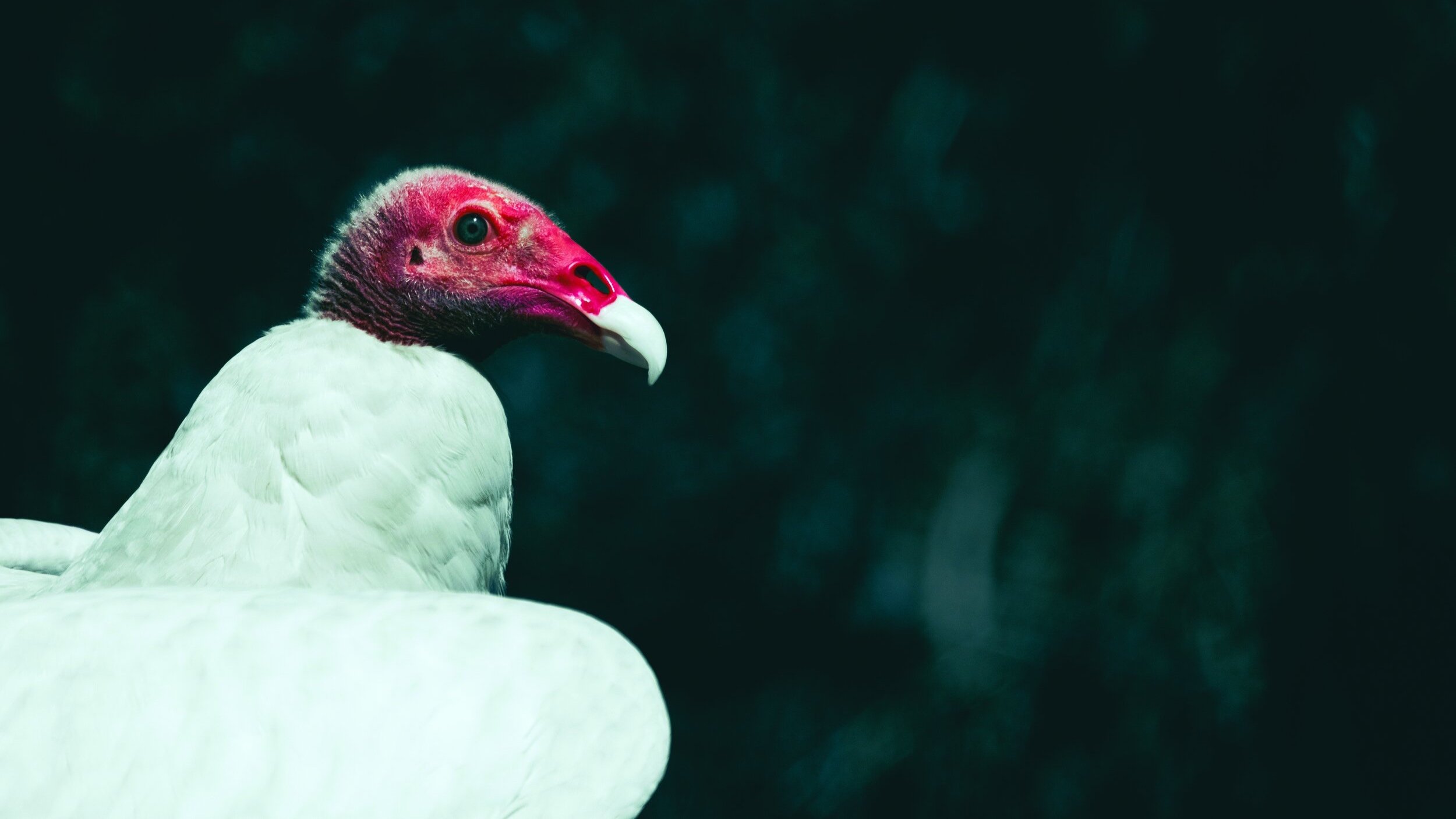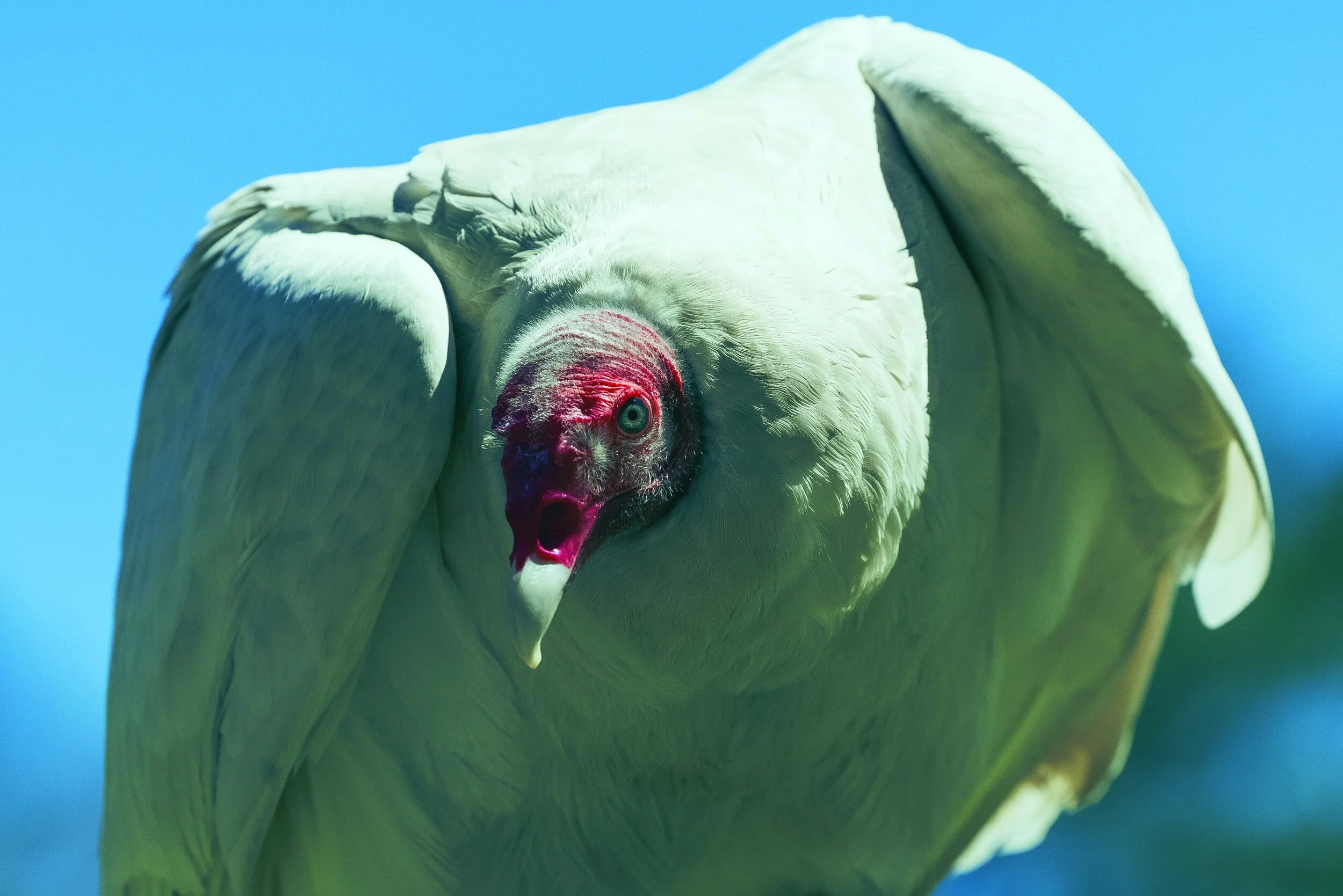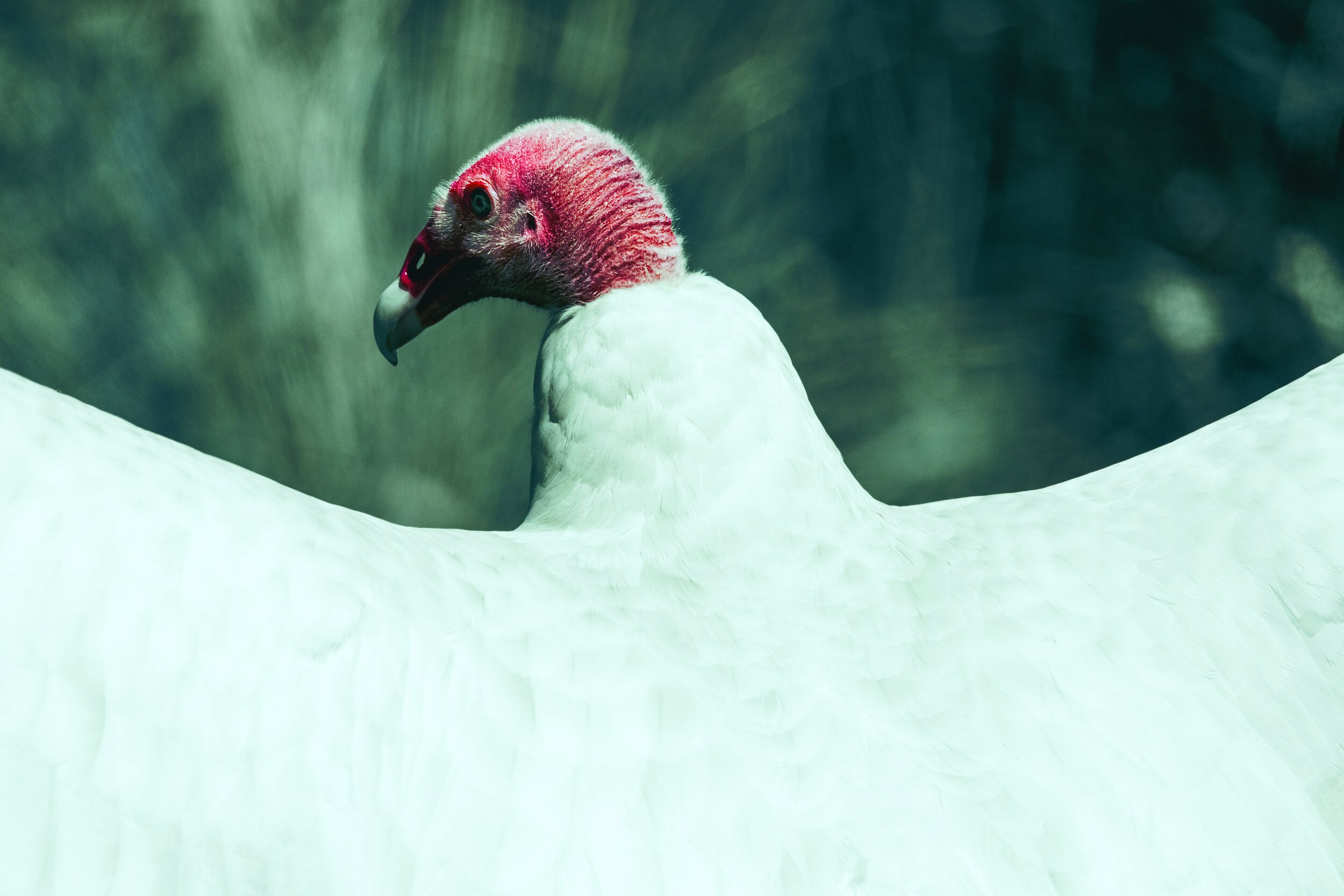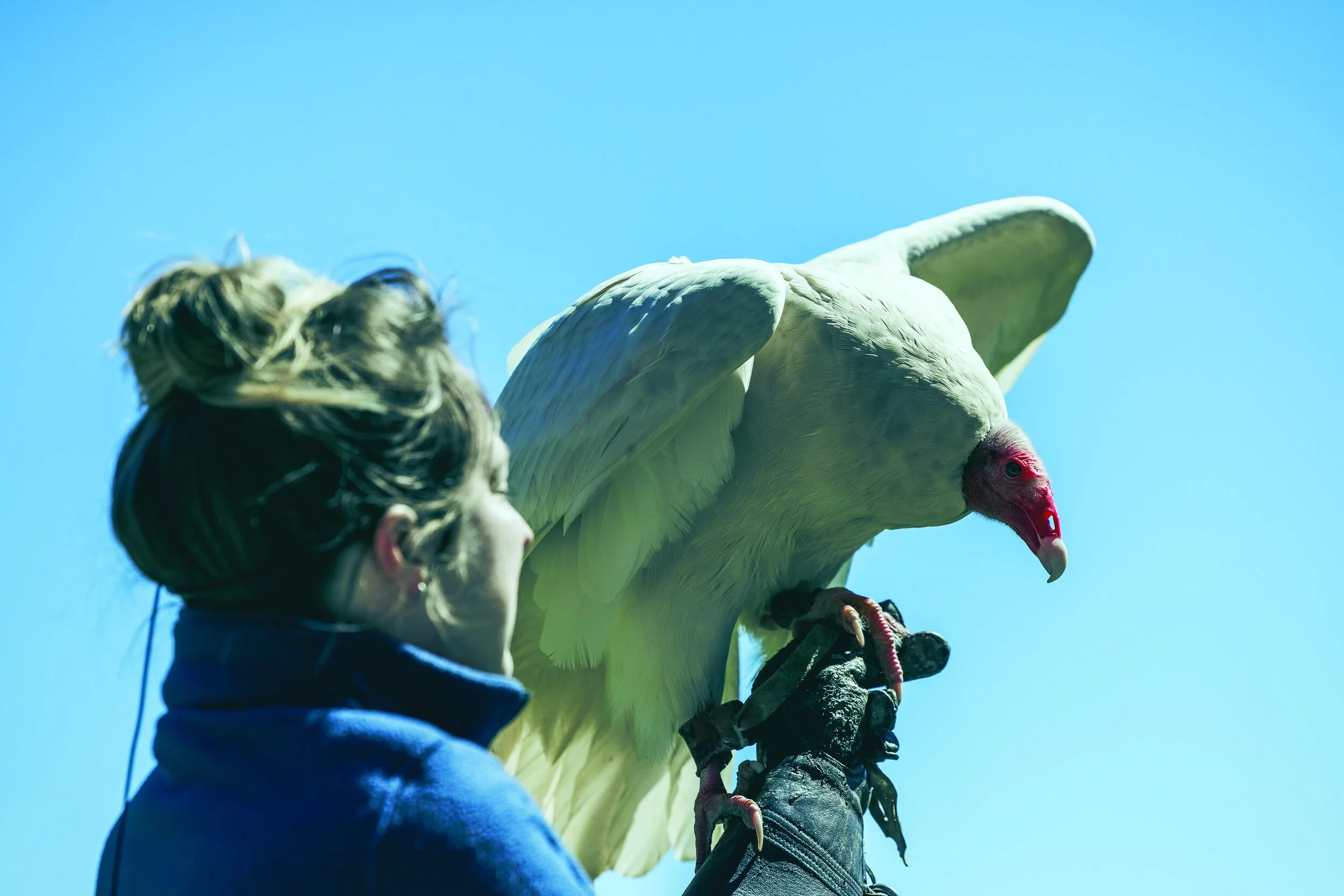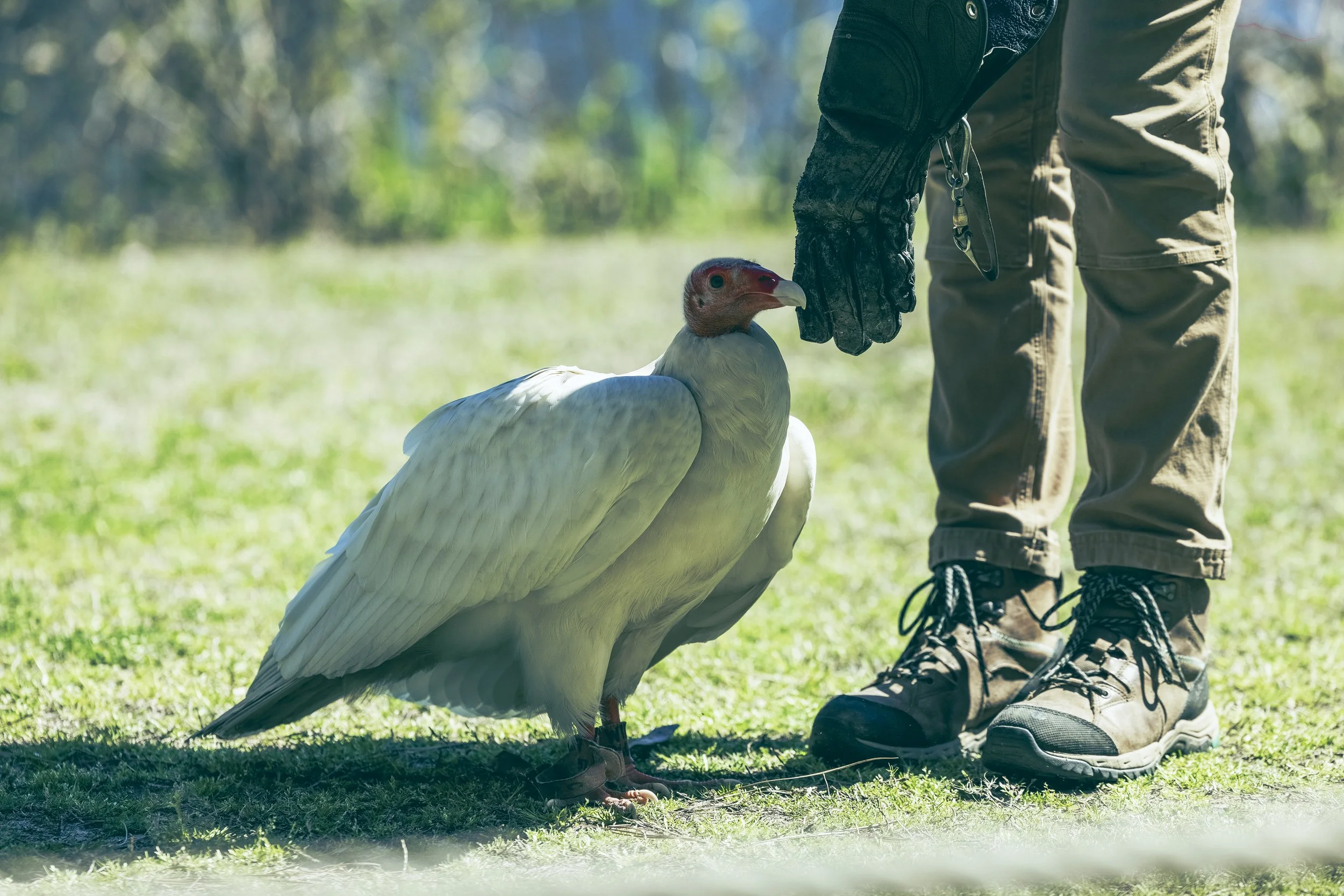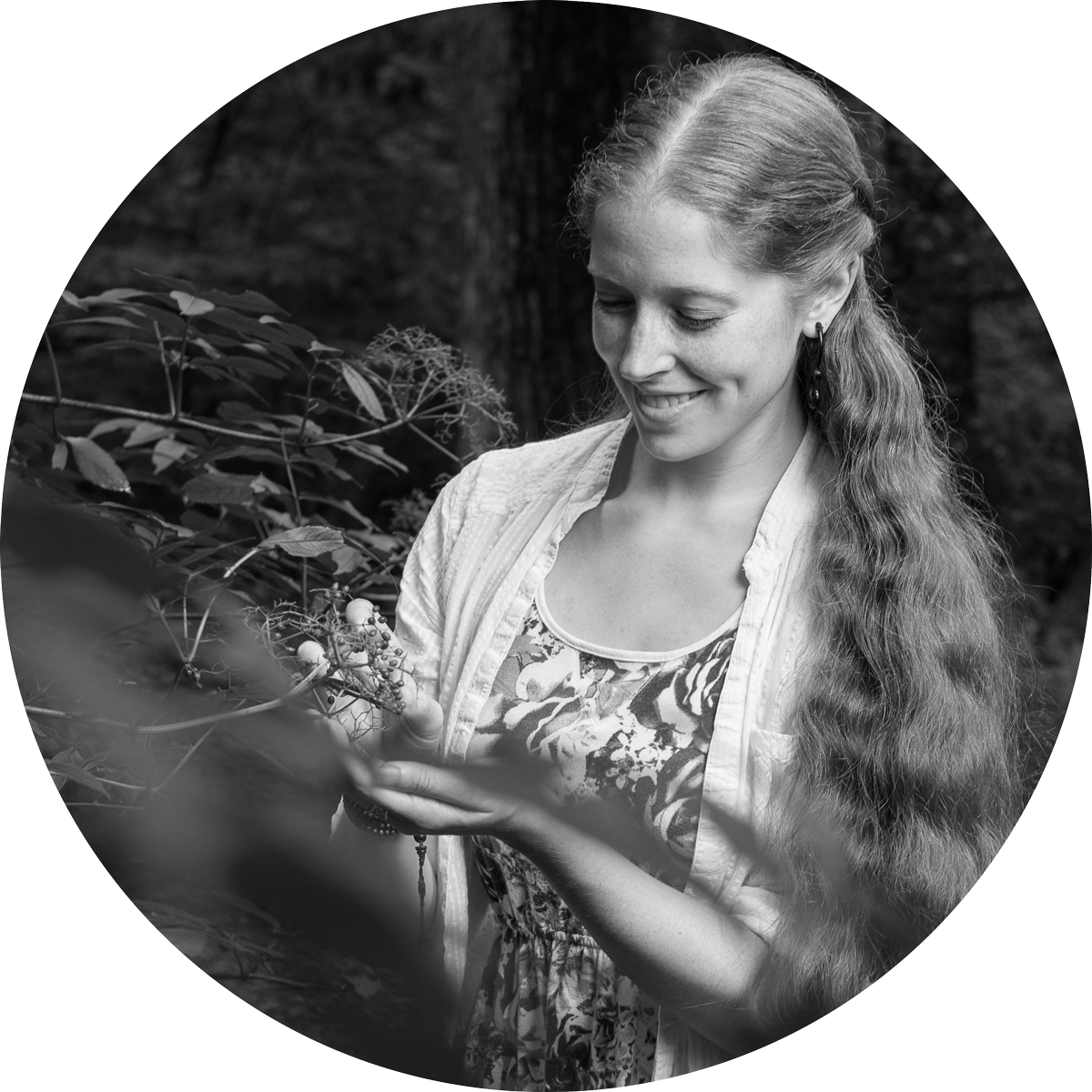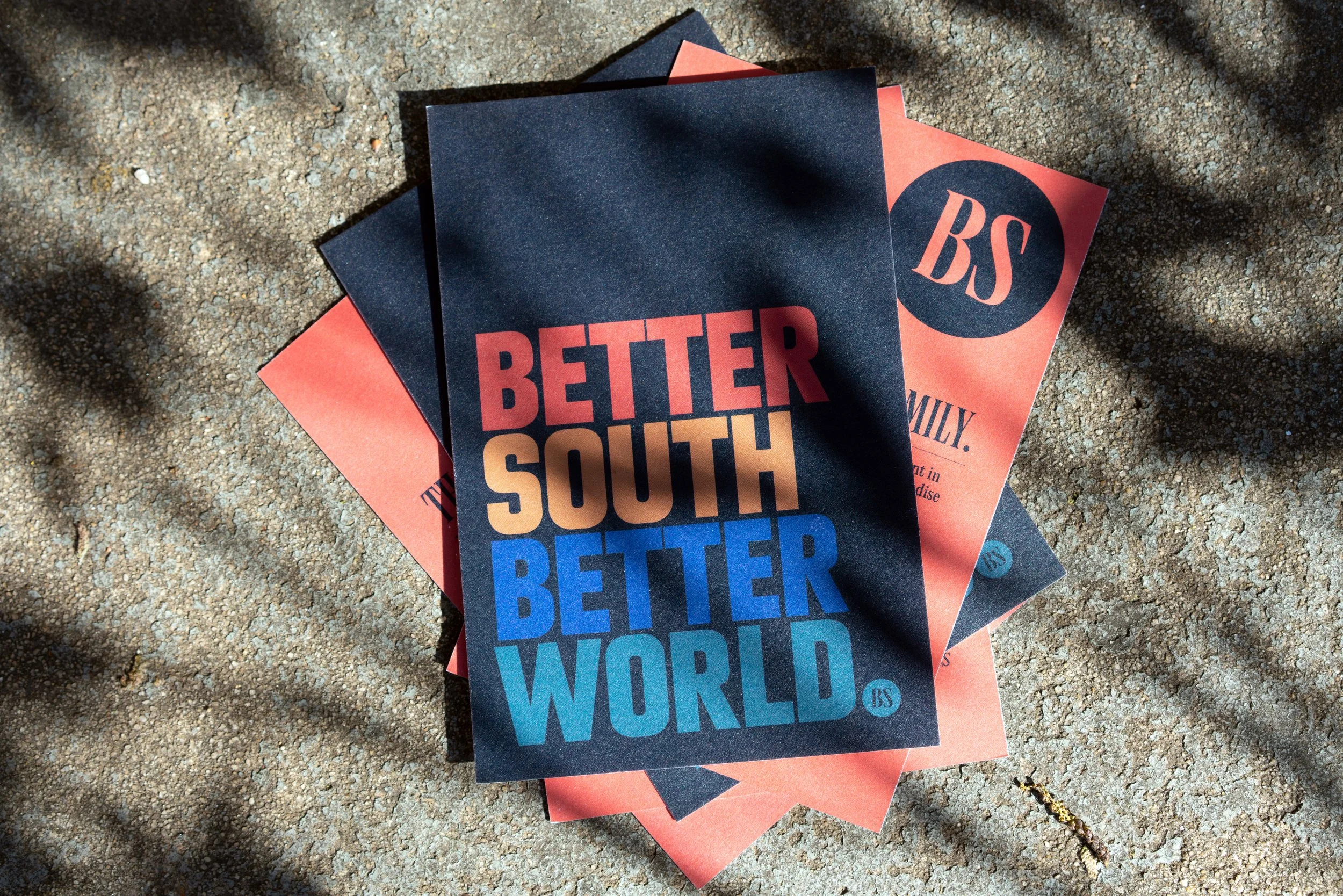In this time of dying and destruction, Atlanta-based writer Kimberly Coburn looked to the turkey vulture to understand the raptor’s embrace of death.
Words by Kimberly Coburn | Photos by Fernando Decillis
The early-summer sun was already relentless by midmorning, pinking my freckled shoulders. I dug around in my bag for sunscreen and came up empty: a rookie move for a redhead spending the afternoon in a little Georgia town just this side of the Alabama line. No sunglasses, either. I shaded my eyes with my hand and looked up.
A hunched ghost stared back.
The vulture’s raw, wrinkled face stood out against his white feathers, stark as blood on snow. He peered down his curved beak at me from his roomy mews. He was the reason I had come. Even so, I hadn’t prepared myself for the scrutiny of this feathered Boo Radley. I felt exposed. Goosebumps pricked my forearms despite the 93-degree heat. Vultures, like other raptors, have scalpel-keen sight. His unblinking gaze husked not only my clothes but my carcass itself, leaving only the architecture of my bones and sinew for vulturine evaluation.
A high, predatory shriek from within a cabin broke his gaze, and he hopped awkwardly out of sight. I rattled myself back into my skin.
I stood at the raptor rehabilitation center at Callaway Gardens, a 2,500-acre public garden and resort in Pine Mountain, Georgia, that is home to more than 15 birds of prey. I had arrived between the two daily exhibitions and followed dusty paths cut between dense pines to the empty amphitheater. It was nothing remarkable: two sturdy perches staked in the patchy grass across from each other, with rows of weathered wooden benches facing them and a mud-colored lake beyond. To the right of the rows of benches stood a narrow wooden cabin with “Staff Only” printed in small white letters on the glass door. A typical shotgun-style cabin, the building was twice as long as it was wide. The only thing notable about it was its second story, a large enclosure surrounded entirely by chain link fencing where the vulture had sat, studying me. An occasional feather drifted down when the breeze blew.
I had come to Callaway because grief makes us do peculiar things. Joan Didion refused to move her dead husband’s shoes on the off chance he might return and need them. My grief was not white-hot like hers — no single searing absence burning like coal in my belly — but rather a diffuse haze that stuck to my skin like the clotted summer air. I did not need to look for a particular loss to explain it. These days, Death is everywhere. Not just your standard, run-of-the-mill death; that’s always been a given. But capital-D Death. Mass-extinction, bleached-coral, climate-emergency Death.
Most creatures go to extreme lengths to avoid their demise. Even simple protozoa frantically waggle their cilia to propel themselves away from perceived dangers, so it’s no wonder that I — a confused and reluctant Homo sapiens — don’t know how to live in a time of dying. When humans walked mostly upright onto the scene, evolution upped the ante. We inherited an elaborate nervous system that hijacks the body in a fit of thundering heartbeats and unreliable sphincters when threatened and, as a bonus, the double-edged gift of a convoluted brain capable of comprehending our inevitable end.
That awareness left us the odd ape out, vulnerable to predation in the dark savannas of our minds. Ever the clever improviser, nature has outfitted her menagerie with adaptations to improve each creature’s odds: thick hides, a coat of quills, the agility to scale steep mountaintops. Unlike our fellow predators who have fangs, claws, and speed, to us humans went thumbs, a complicated sense of self, and perhaps the strangest adaptation of them all: denial.
Death, we like to think, is something that happens to things that are not us. This stubborn belief is as essential as a kidney or eardrum. Without it, we would be inconsolable, endlessly fixating on our own end. In The Denial of Death, cultural anthropologist Ernest Becker notes, “If this fear were constantly conscious, we should be unable to function normally. It must be properly repressed to keep us living with any modicum of comfort.”
Sometimes I worry that I might be a little less functional by Becker’s standards than most of my fellow humans. My brain came with a faulty denial switch. When I’m supposed to be concentrating on client status meetings at 9 on a Monday morning, my head thrums like an angry hive: How many acres of forest can be leveled during an elevator pitch? Should I expect anything different? When the environmentalists among us cluck our tongues and shake our fists at climate change deniers, we are forgetting that ignoring our demise is as natural to us as raiding a coop is to a coyote. We are not wired for this awareness, I tell myself. It seems a gentler interpretation than conceding that the world is full of suicidal idiots.
From the sidelines, denial seems to be slacking on the job. We have sought comfort and — for all our elaborate efforts, our drugs and distractions — we have found little. How do we come to terms with this kind of death? Religions, nations, and cultures are built on the bedrock of our mortality, their texts offering conflicting roadmaps to reconciliation. One — a Psalm, a Song of Ascents — urges me to “lift up mine eyes unto the hills, from whence cometh my help.”
I looked to the hills, and there I found my unexpected comfort: a small, black “V” tilting in a cloudless sky. I don’t think it was the god Psalms had in mind.
In the slantwise, sackcloth logic of grieving, I decided to learn all I could about the turkey vulture, the disparaged buzzard. Maybe these bald-faced undertakers knew something I didn’t. They are neither riddled with the urgency of the predator nor the anxiety of prey because carrion is never in short supply and the vulture’s own meat is no animal’s delicacy. While the rest of us run, gallop, and slither from death, buzzards sniff it out, hurtle toward it. I thought if I apprenticed myself to these wake workers, maybe I could glean the arcane wisdom they keep suspended far above us. That’s why I had scheduled this visit to Callaway to meet a particularly unique specimen.
Meagan DuVall, manager and lead bird trainer, welcomed me into a snug office with floor-to-ceiling wire enclosures. To train a bird for educational programming, it must be non-releasable to the wild. This left Callaway a veritable island of misfit raptors, their keenest abilities blunted by a world no longer wild. Gandalf, the pint-sized eastern screech owl, had been hit by a car, rendering him blind in one milky eye. Olive, the barred owl, was a human imprint; her huge, vacant stare lacked any trace of the wariness necessary for survival. Tilden, the red-tailed hawk, had been shot by an overzealous chicken farmer.
Owls and hawks struggle to acclimate to a world of plate glass and asphalt. Rising temperatures evict the Mississippi kite and Baltimore oriole from their namesake homes. But the turkey vulture — like the American crow and mourning dove — annexes ever more acreage. He’ll roost as contentedly on a cellphone tower as on a rotting tree, apparently unruffled by ecological unraveling. In a dying world, the buzzard is utterly at home.
But Wilson, the bird I had come to see, was different. While most turkey vultures have umber feathers, Wilson’s were the color of bleached bone. DuVall explained that he was leucistic, a condition similar to albinism but without the complete absence of melanin. “Someone found him struggling to survive alongside a highway in Alabama. We named him Wilson after [biologist] E.O. Wilson, but we’re honestly not sure if he’s male or female.” Many birds of prey, like hawks, demonstrate a trait called sexual dimorphism, where sex can be distinguished by size or coloring. Male and female vultures, however, are virtually identical to the eye.
“Let me go get him,” DuVall said, clearly eager to show off Callaway's least popular resident to someone who cared. She grabbed a pair of leather falconry gloves and opened the door. We stepped back into the thick heat of the empty amphitheater. Only expert bird handlers are allowed to work with the vultures because of how extraordinarily smart and challenging the birds can be. Some estimates put their intelligence on par with that of a 3-year-old child.
Meagan DuVall is the manager and lead bird trainer at the raptor rehabilitation center at Callaway Gardens, a 2,500-acre public garden and resort in Pine Mountain, Georgia, that is home to more than 15 birds of prey.
I’ve always had a soft spot for the maligned vulture. I’m a novice bird-watcher at best, but they were the first bird I learned to identify in flight, their tipsy wobble distinguishing them from the hawk’s flap-flap-glide. While other birders might have turned away, their hopes for red-tails or eagles deflated by “just another buzzard,” I remained transfixed by their hypnotic spirals. It’s easy to overlook the common. It’s easier still to write off a bird as likely to have its head plunged neck-deep in roadkill on the side of a highway as to wing through the heavens.
Moments later, DuVall reappeared with Wilson. He was easily half her height, but she balanced him gently on her gloved forearm. For all its bulk, the average buzzard weighs less than 4 pounds. Experts attribute their capacity to glide endlessly on the thermals to their low weight relative to their long wingspan.
Wilson shuffled uncomfortably in his jesses from one scaled foot to the other. His long talons scratched dully against the dry leather. To see him was to look through closed eyes, the pale afterimage of a vulture against the sun emblazoned in negative.
“His coloring makes his feathers fragile,” DuVall explained, her blue eyes wincing, as if it hurt to mention. Melanin in the chocolate-colored feathers of most vultures strengthens them; the lack in Wilson’s feathers leaves them brittle and more susceptible to breaking. Ragged wings can’t hold the air beneath them, and a grounded vulture must learn a different way through the world. The trainers do all they can to create a life as close to wild as possible. “He can’t fly well,” DuVall said. It sounded almost like an apology. “But he can sort of glide a short distance now.”
DuVall raised her arm toward a perch. Wilson hesitated. She rested the back of her hand against the wood, opening her palm to reveal a secreted scrap of meat and fur. Wilson clambered onto the perch, wobbling and flaring out his wings to regain his balance. He gobbled down the snack and settled in, surveying the quiet scene before him. Unlike most vultures’ reddish-brown irises, Wilson’s eyes were the color of faded chicory flowers. The pale blue contrasted sharply with his ruddy wrinkles.
I was glad I had armed myself with enough information to appreciate his strange beauty. The buzzard’s face is the ultimate death mask, flawlessly designed for digging into the dark cavities of the dead and emerging unpolluted; the bacteria and microbes dwelling in the recesses of a carcass find no quarter on his naked visage. Evolution equipped these ugly alchemists with the tools to transmute carcass into feather, earth into air. Their innards are equally well suited for their macabre diet: pathogens are eradicated by the caustic acid roiling in their bellies, strong enough to kill anthrax and rabies. Their Latin name, Cathartes aura, means “golden purifier.”
Ecce Cathartes aura, qui manducat peccata mundi. Behold the buzzard, who eats the sins of the world.
Wilson ruffled his wings and then stretched them out a full 5 feet. He looked like he wanted to embrace the sun. Though we envision vultures lurking in graveyards in the dead of night, they’re sun birds. They bathe in its light, travel on the thermals of its warmth. In this “horaltic pose,” DuVall explained to me, vultures utilize the sun’s ultraviolet rays to kill off bacteria in their wings, another adaptation equipping them for their dawn patrol along the frontier between life and death, sustenance and decay.
I had never realized until being so close to a vulture that their nostrils are perforated — you can see clean through to the other side like a keratin keyhole. It seemed incongruous that nature would build such a fine instrument with such rudimentary architecture. The buzzard has one of the keenest senses of smell in the avian world, leading him to the faint perfume left in death’s wake up to a mile away. Other carrion birds depend on the vulture and his ferryman’s awareness of the comings and goings of life. They follow him to the glass-eyed doe in the woods, the grimacing opossum on the shoulder of the road, just to jostle him aside. He gives way. Called “peace eagle” by the Cherokee, the buzzard is incapable of killing or rending flesh; his talons are too weak. Instead, he hobbles aside for another raptor to slash into the belly buffet and waits his turn in a ravenous queue.
Our neural rigging for smell, clumsy by comparison, sits snugly within our limbic system: a straight shot for recollections and associations. The smell of death is one we do not forget. I wanted to grasp Wilson by his delicate wing bones and demand he teach me how to welcome it.
It’s no use, though. Wilson doesn’t know. And even if he did, he couldn’t tell me his secrets. The only sounds he can make are limited to airy hisses and occasional grunts. Humans have the fleshy folds of a larynx. Most birds sound the forked flute of a syrinx. And the vulture has nothing at all. The serpentine passageway of his throat holds no machinery for music or sound. Death’s most dedicated avian attendants are mostly mute.
The buzzard is no stranger to interceding on behalf of a world in chaos. A Lenni Lenape story recounts how a vulture pushed the sun back when the world was too hot; no other animal was equal to the task. The heat of it seared his face bald and red, charred his rainbow feathers black; the smoke stole his beautiful voice. Or, when the fresh world was born out of water and mud in the origin story of the Cherokee, a buzzard was sent to find dry land. He flew for days until he found a towering mound of clay, still soft, full of promise. In his weariness, his flight sagged. His feathers gouged the muck when he flapped skyward, carving the deep valleys and ridges of the Great Smoky Mountains. Native Americans recognize a vulture’s place in the order of things: there in the beginning, there at the end, winding the clock of days as they wheel through the sky.
Wilson fixed me with a single sky-colored eye. The curvature of his rigid beak looked like a smile. He had stood nervously on this perch every day the weather was fair — twice a day in the busy months — for the Birds of Prey show. Frustrated parents would corral their children, high on sugar and summer vacation, into wooden pews under the searing sun. They’d “ohh” and “ahh” as the barred owl flew inches from their heads. Some kid would reach up to touch her and, blessedly, miss. They’d all gasp at the red-tailed hawk, darting from one perch to another for a scrap of rabbit. But when Wilson stood with his wings spread wide on a makeshift altar before them — a living myth, a forgotten god — they would only squirm in awkward silence.
He began to pant.
“We should get him out of the sun. He can get burnt if he’s out too long.” She held out her glove about 2 feet below the perch. The shuffling fear crept back into Wilson’s dinosaur feet. He slowly tipped forward, dramatically flapping through an ungraceful descent.
On my drive home, vultures hovered on the highway’s horizon, conjoined slivers of darkness against the late-afternoon light. I swiveled my head to watch several picking at the bloated carcass of a deer on the shoulder of the road with apparently zero concern for the cars barreling by at 80 mph. I imagined a fledgling Wilson, abandoned by his family on the side of some Alabama freeway: lost, alone, tethered to earth — his absent flight feathers like missing teeth, broken piano keys. He would have died alongside that asphalt without intervention, but it would have been a vulture’s death. He’d have cycled from earth to the heavens as easily as rain.
How effortlessly these birds untangle the lies we spin around death. The endings that fill us with anxiety nourish them. I wanted to mainline that kind of freedom. I wanted to float for hours with no millstone of loss around my neck, to see it all from a 10,000-foot vantage.
In humanity’s desperate bid to outrun mortality, we have instead barreled headlong into it. But for all our neuroses and attempts to exempt ourselves from nature’s order, we, too, are of this world, fashioned from the same stuff as beak and feather. Our denial, our refusal of death, may blind us to stark realities, but it has other faces. That denial can be generous. It can look like pulling over onto the shoulder of the highway where a small, broken white bird pants under an unforgiving sun, deciding: not today, not on my watch. It can look like a few phone calls to nearby animal rescues; like wrapping a ratty towel from the trunk around his dirty, useless wings. It can look like carrying his impossibly weightless body, soured with decay, back from the edge of the borderlands, ushering him into a new world, into our world, where death is an aberration and its attendants unwelcome.
Wilson’s survival, like ours, comes at a cost. Unburnt but earthbound, he is barred from the sanctuary of the sky — a liminal specimen of a liminal species. Perhaps, as DuVall suggested, he never took to the air because his parchment feathers are too fragile. Or maybe living among us tamped his hollow bird-bones too full of grief for flight.
I had thought that just to be near a vulture might be enough. I had convinced myself that I might find some enlightenment at its gnarled feet. Any remedy seems sane when everything feels this crazy. The sun is getting too close again, and we don’t have the wings or wherewithal to push it back. Our feet are stuck in the clay.
Instead, I met Wilson: another refugee of the Anthropocene, a misfit, not quite like his kind — like me. He might not have been the teacher I was looking for, but Wilson gave me selfish hope in a quirk of cosmic arithmetic, a transitive property of more-than-human kinship. If a turkey vulture the color of chalk can become the slightest bit human by dint of proximity and need, can we become a little vulture? If we stand within their kettle, their lofty wheels-within-wheels, and do not let the sun shut our eyes, can we consume all the death we’ve made and give it wings?
The next time you see a vulture, center yourself beneath his lazy circumference. Tell me it doesn’t feel like a benediction.
Kimberly Coburn is an Atlanta-based writer, organizer, and educator. In 2013, she founded The Homestead Atlanta — a hands-on, regenerative education collective — and she continues to explore the intersection between craft, the human spirit, and the natural world.
Fernando Decillis has worked on campaigns for Coca-Cola, Reebok, Wild Turkey bourbon, and many more. His work has been featured in publications such as AdWeek, Smithsonian magazine, CNN, and Bloomberg Businessweek. In 2015, Fernando was honored by the International Photography Awards with the title of Advertising Photographer of the Year and won a Communication Arts Award of Excellence. He was nominated for International Photographer of the Year for the 2015 Lucie Awards.

